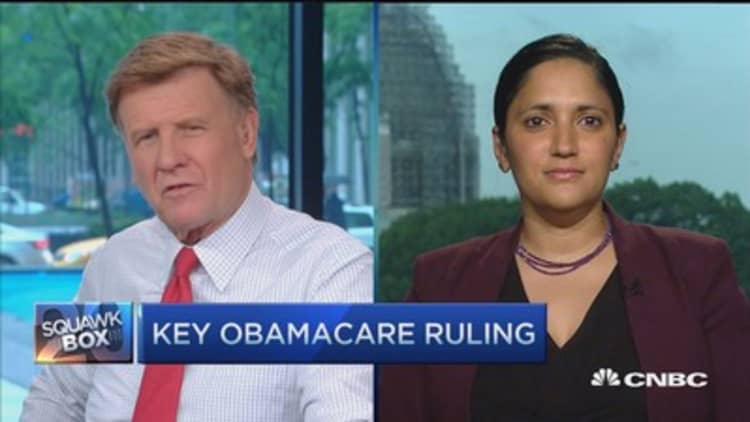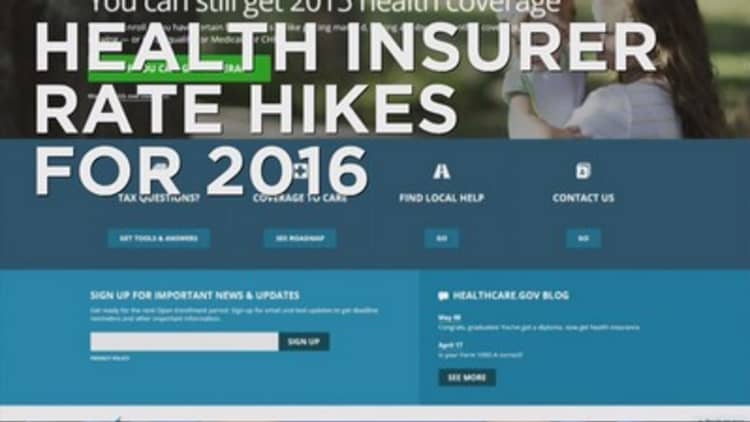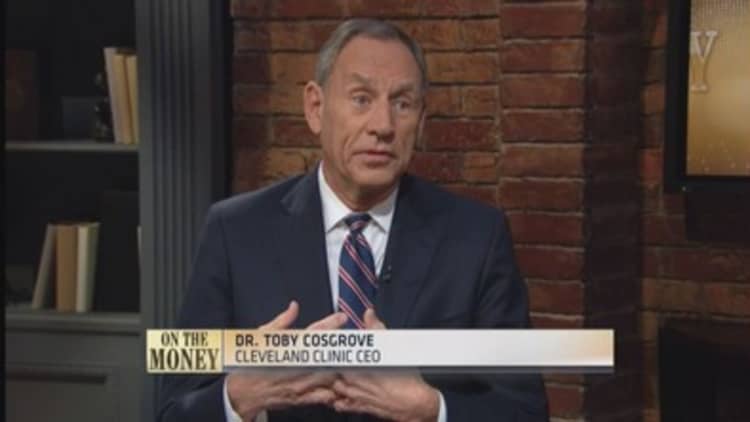



There are some eye-popping proposed Obamacare rate increases for next year. But whether they turn out to be the norm or the exception won't be known until October.
The federal agency in charge of Obamacare revealed on Monday afternoon details of many of the Obamacare insurance plans requesting premium rate hikes of 10 percent or more for 2016.
The data, which can be accessed at RateReview.HealthCare.gov. includes exactly how much more an insurer wants to charge next year, and the justification for that increase.
But information about lesser price increases being proposed, or even proposed price decreases, were not released. That makes it impossible, for the moment, to determine just how much insurers want to raise their premiums overall in the United States for 2016.
The Centers for Medicare and Medicaid Services released the proposed hikes of 10 percent or more in 37 states using the federal HealthCare.gov insurance platform, as well as several other states using their own Obamacare insurance exchanges. Two of the biggest states, California and New York, do not have proposed rates on RateReview.HealthCare.gov yet.
Both plans sold on government-run Obamacare exchanges and ones sold off those exchange are included on RateReview.HealthCare.gov.
Read MoreGOP Obamacare 'fix' has big risks
A check of the site for Georgia found that Aetna HMO plan sold on HealthCare.gov is seeking a 15.57 percent increase in its monthly premiums. And Alliance Health Plans in Georgia is asking for a whopping 37.85 percent premium hike for its SoloCare individual plan sold on that same federal insurance exchange.
In the Midwest, Blue Cross Blue Shield of Illinois asked for price increases of 12.83 percent for one plan, but also wants a 29.09 percent hike for another plan, and a 38.24 percent bump for a third plan. More than 329,000 current Blue Cross Blue Shield Customers are in those or similar plans now.
Blue Cross Blue Shield, in its rate filing wrote, "The main driver of the increase in the proposed rates is that the actual claims experience of the members in these individual ... policies is significantly higher than expected."
CMS noted, however, that "insurance companies project that most people will be enrolled with proposed rate increases of less than 10 percent."
"The Affordable Care Act requires that insurers planning to significantly increase plan premiums submit their rates to either the state or federal government for review," says the Rate Review page on HealthCare.gov. "The rate review process is designed to improve insurer accountability and transparency. It ensures that experts evaluate whether the proposed rate increases are based on reasonable cost assumptions and solid evidence and gives consumers the chance to comment on proposed increases."
But insurance experts said the incomplete data release, and the fact that regulators can in many states affect the final rate determinations, makes it unclear whether overall Obamacare rates are likely to be significantly higher in 2016, or whether more moderate price hikes can be expected.
Proposed rates can, and are likely to change before becoming final in October, right before open enrollment for Obamacare plans for 2016 begin. And the proposed rate increases released Monday reflect suggested prices before the application of tax credits, or subsidies, that nearly 90 percent of Obamacare exchange customers receive. Those subsidies can significantly reduce monthly premiums for people with low and moderate incomes.
"This is a very incomplete picture because it doesn't include the plans that are seeking small increases, or even decreases," said Larry Levitt, a senior vice president at the Kaiser Family Foundation, and a leading Obamacare expert. "Analyzing this is like trying to gauge the average height of Americans by looking at only NBA players."
"These increases aren't final, and they're balanced out in many case by insurers who are not increasing premiums by that much," Levitt said.
Still, while "I do think it's too early to generalize," Levitt said, "I do think that the increases in general will be bigger for 2016 than in 2015."
Read MoreDon't mess with Medicaid expansion? Texas' lesson
"There's no question there will be some steep increases for 2016, which highlights once again the need for consumers to shop around, because better deals will be available."
Cori Uccello, an actuary and senior health fellow of the American Academy of Actuaries said, "I wouldn't use this [data] to determine what the average rate increases will be" for Obamacare plans in 2016.
"Looking at rate submissions is not the same as what the rates are going to be," said Uccello, whose group is made up of experts who help insurers set prices for their health plans.
CMS does not have power over how much insurers can charge for Obamacare plans, but state regulators in about two-thirds of the United States do have the power to influence how much plans can charge.
CMS's posting of the proposed increases of 10 percent or more, which the agency did not do last year, also gives the public the opportunity to comment on the insurers' higher range of proposed hikes.
"The rate review process kicks off an important set of steps designed to provide consumers and others the opportunity to weigh in on proposed rate increases of 10 percent or more," said Andy Slavitt, the acting CMS administrator. "These specific rates will be subject to vigorous rate review and revision and the final rates customers will see this fall will reflect the breadth of choice and competition in the marketplace."
In a press release announcing the data, CMS noted that Obamacare customers "do not have to stay in their plans if they do not agree with the rate increases or other features of their plan.
"For 2015, 29 percent of all HealthCare.gov consumers who re-enrolled in coverage shopped and chose different plans," CMS said. The data dump by CMS sent insurance researchers scrambling to look at the proposed rate increases
"We're pulling down the rate filings, and we're trying to take a look at them," said Kev Coleman, head of research and data at HealthPocket, a insurance premium comparison site. "We're not expecting to have any type of preliminary analysis until early next week."
Read MoreObamacare case is political pickle for Republicans
"It's a very tedious, manual process," said Coleman. "But it's really important because this helps consumers understand their health-care cost."
Coleman said he had predicted in 2012 that Obamacare plans would not clearly reflect the cost of insuring people until 2016.
He said that is because in the first year of Obamacare plans, 2014, open enrollment continued through mid-May, only a month or so before proposed rates were due for 2015. The tight time frame, and the fact that most customers signed up in the final two months of open enrollment, gave insurers very little data about their customers' health status and utilization of medical benefits.
Insurers now have more extensive data on which to base their rate submissions.
"This year is really interesting for those of us who are analyzing the health insurance market," Coleman said.


